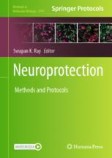Search
Search Results
-
Primary Hypothyroidism and Alzheimer’s Disease: A Tale of Two
Hypothyroidism (HPT) HPT could be a risk factor for the development and progression of Alzheimer’s disease (AD). In addition, progressive...

-
Switch of innate to adaptative immune responses in the brain of patients with Alzheimer’s disease correlates with tauopathy progression
Neuroinflammation is a key feature of Alzheimer’s disease (AD). In this work, analysis of single- cell RNA-sequencing (scRNA-seq) data obtained from...

-
Environmental Toxins and Alzheimer’s Disease: a Comprehensive Analysis of Pathogenic Mechanisms and Therapeutic Modulation
Alzheimer’s disease is a leading cause of mortality worldwide. Inorganic and organic hazards, susceptibility to harmful metals, pesticides,...

-
Quantitative Investigation of Neuroprotective Role of ROR1 in a Cell Culture Model of Alzheimer’s Disease
Cytoskeletal and microtubule atrophy are major hallmarks of Alzheimer’s disease (AD). A method to investigate endogenous proteins that can...
-
Exercise mimetics: a novel strategy to combat neuroinflammation and Alzheimer’s disease
Neuroinflammation is a pathological hallmark of Alzheimer’s disease (AD), characterized by the stimulation of resident immune cells of the brain and...

-
Iatrogenic Alzheimer’s disease in recipients of cadaveric pituitary-derived growth hormone
Alzheimer’s disease (AD) is characterized pathologically by amyloid-beta (Aβ) deposition in brain parenchyma and blood vessels (as cerebral amyloid...

-
Clonal hematopoiesis is associated with protection from Alzheimer’s disease
Clonal hematopoiesis of indeterminate potential (CHIP) is a premalignant expansion of mutated hematopoietic stem cells. As CHIP-associated mutations...

-
Biochemical Platelet Markers of Cognitive Impairments in Alzheimer’s Disease
Abstract —An increase in the prevalence of different cognitive disorders, including Alzheimer’s disease (AD), determines the relevance of the search...
-
Simple model systems reveal conserved mechanisms of Alzheimer’s disease and related tauopathies
The lack of effective therapies that slow the progression of Alzheimer’s disease (AD) and related tauopathies highlights the need for a more...

-
Passive immunotherapy for Alzheimer’s disease: challenges & future directions
Passive immunotherapy with specific antibodies targeting Amyloid β (Aβ) peptide or tubulin-associated unit (tau) protein has emerged as a promising...
-
Metal Chelators as a Potential Therapeutic Agent for Alzheimer’s Disease
Alzheimer’s disease (AD) is a neurological condition that causes behavioural abnormalities and a progressive decline in intellectual abilities....
-
The Role of RIN3 Gene in Alzheimer’s Disease Pathogenesis: a Comprehensive Review
Alzheimer’s disease (AD) is a globally prevalent form of dementia that impacts diverse populations and is characterized by progressive...

-
Dysbiosis and Alzheimer’s disease: role of probiotics, prebiotics and synbiotics
Alzheimer’s disease (AD) is a neurodegenerative disease characterized by dementia and the accumulation of amyloid beta in the brain. Recently,...

-
The landscape of programmed cell death-related lncRNAs in Alzheimer’s disease and Parkinson’s disease
This study delivers a thorough analysis of long non-coding RNAs (lncRNAs) in regulating programmed cell death (PCD), vital for neurodegenerative...

-
Biomarkers in Alzheimer’s disease: role in early and differential diagnosis and recognition of atypical variants
BackgroundDevelopment of in vivo biomarkers has shifted the diagnosis of Alzheimer’s disease (AD) from the later dementia stages of disease towards...

-
Brown adipose tissue and alzheimer’s disease
Alzheimer’s disease (AD), the most common type of senile dementia, is a chronic neurodegenerative disease characterized by cognitive dysfunction and...

-
Prevalence, distribution, and severity of cerebral amyloid angiopathy differ between Lewy body diseases and Alzheimer’s disease
Dementia with Lewy bodies (DLB), Parkinson’s disease dementia (PDD), and Parkinson’s disease (PD) collectively known as Lewy body diseases (LBDs) are...

-
Acupuncture Treatment for Alzheimer’s Disease
Alzheimer’s disease (AD) is a neurodegenerative disease that costs a growing burden on patients, family members, healthcare systems, and society...
-
The neuroimmune axis of Alzheimer’s disease
Alzheimer’s disease (AD) is a genetically complex and heterogeneous disorder with multifaceted neuropathological features, including β-amyloid...

-
Cerebrospinal fluid proteomics define the natural history of autosomal dominant Alzheimer’s disease
Alzheimer’s disease (AD) pathology develops many years before the onset of cognitive symptoms. Two pathological processes—aggregation of the...

